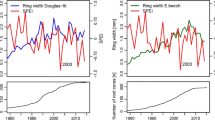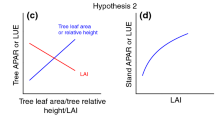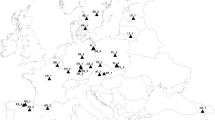Abstract
Mixed-species plantation forests are of high interest both because of their potentially superior productivity and multi-functionality benefits over monocultures. However, how trees of different species interact at the canopy level in mixed forests remains unclear, even at young growth stages. We tested whether crown shape and size and stand-level canopy packing were affected by stand composition and how mixture effects varied with stand density and irrigation. We measured crown attributes in pure and mixed plots of two light-demanding species, silver birch (Betula pendula Roth) and maritime pine (Pinus pinaster Ait.), in a 10-year-old tree diversity experiment (ORPHEE). This allowed us to estimate tree-level crown volumes and stand-level canopy packing. We found that (i) at the tree level, stand composition influenced crown-stem allometric relationships in pine but not in birch, (ii) mixture led to greater crown and tree dimensions in pine, but to the opposite for birch, (iii) the changes in crown volume resulted in a higher canopy packing in mixed stands, only at high density and with no irrigation, i.e., under highest constraints for light availability but also soil water availability, contrary to initial expectations. This study sheds light on the effects of water constraints on the aboveground mechanistic processes that explain greater productivity in young mixed plantations, and improves our understanding of canopy packing in mixed stands.






Similar content being viewed by others
Data availability
The dataset analyzed during the current study are available from the corresponding author on reasonable request.
References
Abad Viñas R, Caudullo G, Oliveira S, de Rigo D (2016) Pinus pinaster in Europe: distribution, habitat, usage and threats. In: San-Miguel-Ayanz J, de Rigo D, Caudullo G, et al (eds) European Atlas of Forest Tree Species. Publ. Off. EU, Luxembourg, p e012d59+
Aldea J, Bravo F, Vázquez-Piqué J, et al (2021) Differences in stem radial variation between Pinus pinaster Ait. and Quercus pyrenaica Willd. may release inter-specific competition. For Ecol Manage 481:118779. https://doi.org/10.1016/j.foreco.2020.118779
Altinalmazis-Kondylis A, Muessig K, Meredieu C et al (2020) Effect of tree mixtures and water availability on belowground complementarity of fine roots of birch and pine planted on sandy podzol. Plant Soil 457:437–455. https://doi.org/10.1007/s11104-020-04741-8
Ammer C (2019) Diversity and forest productivity in a changing climate. New Phytol 221:50–66. https://doi.org/10.1111/nph.15263
Andivia E, Ruiz-Benito P, Díaz-Martínez P et al (2020) Inter-specific tolerance to recurrent droughts of pine species revealed in saplings rather than adult trees. For Ecol Manage 459:117848. https://doi.org/10.1016/j.foreco.2019.117848
Augusto L, Bakker MR, Morel C et al (2010) Is ‘grey literature’ a reliable source of data to characterize soils at the scale of a region? A case study in a maritime pine forest in southwestern France. Eur J Soil Sci 61:807–822. https://doi.org/10.1111/j.1365-2389.2010.01286.x
Barbeito I, Collet C, Ningre F (2014) Crown responses to neighbor density and species identity in a young mixed deciduous stand. Trees 28:1751–1765. https://doi.org/10.1007/s00468-014-1082-2
Barbeito I, Dassot M, Bayer D et al (2017) Terrestrial laser scanning reveals differences in crown structure of Fagus sylvatica in mixed vs. pure European forests. For Ecol Manage 405:381–390. https://doi.org/10.1016/j.foreco.2017.09.043
Barton K (2019) MuMIn: multi-model inference. R Package Version 1(43):15
Baskerville GL (1972) Use of logarithmic regression in the estimation of plant biomass. Can J for Res 2:49–53. https://doi.org/10.1139/x72-009
Beck P, Caudullo G, de Rigo D, Tinner W (2016) Betula pendula, Betula pubescens and other birches in Europe: distribution, habitat, usage and threats. In: San-Miguel-Ayanz J, de Rigo D, Caudullo G, et al (eds) European Atlas of Forest Tree Species. Publ. Off. EU, Luxembourg, p e010226+
Belluau M, Vitali V, Parker WC et al (2021) Overyielding in young tree communities does not support the stress-gradient hypothesis and is favoured by functional diversity and higher water availability. J Ecol 1365–2745:13602. https://doi.org/10.1111/1365-2745.13602
Bertness MD, Callaway R (1994) Positive interactions in communities. Trends Ecol Evol 9:187–191. https://doi.org/10.1016/0169-5347(94)90087-6
Binkley D, Campoe OC, Gspaltl M, Forrester DI (2013) Light absorption and use efficiency in forests: Why patterns differ for trees and stands. For Ecol Manage 288:5–13. https://doi.org/10.1016/j.foreco.2011.11.002
Bréda NJJ (2003) Ground-based measurements of leaf area index: a review of methods, instruments and current controversies. J Exp Bot 54:2403–2417. https://doi.org/10.1093/jxb/erg263
Brockerhoff EG, Barbaro L, Castagneyrol B et al (2017) Forest biodiversity, ecosystem functioning and the provision of ecosystem services. Biodivers Conserv 26:3005–3035. https://doi.org/10.1007/s10531-017-1453-2
Cameron A (1996) Managing birch woodlands for the production of quality timber. Forestry 69:357–371. https://doi.org/10.1093/forestry/69.4.357
Cardinale BJ, Duffy JE, Gonzalez A et al (2012) Biodiversity loss and its impact on humanity. Nature 486:59–67. https://doi.org/10.1038/nature11148
Castagneyrol B, Kozlov MV, Poeydebat C et al (2019) Associational resistance to a pest insect fades with time. J Pest Sci. https://doi.org/10.1007/s10340-019-01148-y
Castagneyrol B, Giffard B, Péré C, Jactel H (2013) Plant apparency, an overlooked driver of associational resistance to insect herbivory. J Ecol 101:418–429. https://doi.org/10.1111/1365-2745.12055
Castagneyrol B, Bonal D, Damien M et al (2017) Bottom-up and top-down effects of tree species diversity on leaf insect herbivory. Ecol Evol 7:3520–3531. https://doi.org/10.1002/ece3.2950
Cattaneo N, Schneider R, Bravo F, Bravo-Oviedo A (2020) Inter-specific competition of tree congeners induces changes in crown architecture in Mediterranean pine mixtures. For Ecol Manage 476:118471. https://doi.org/10.1016/j.foreco.2020.118471
Condés S, Aguirre A, del Río M (2020) Crown plasticity of five pine species in response to competition along an aridity gradient. For Ecol Manage 473:118302. https://doi.org/10.1016/j.foreco.2020.118302
Corcket E, Alard D, Halder I et al (2020) Canopy composition and drought shape understorey plant assemblages in a young tree diversity experiment. J Veg Sci 31:803–816. https://doi.org/10.1111/jvs.12903
del Río M, Bravo-Oviedo A, Ruiz-Peinado R, Condés S (2019) Tree allometry variation in response to intra- and inter-specific competitions. Trees 33:121–138. https://doi.org/10.1007/s00468-018-1763-3
Demarez V, Duthoit S, Baret F et al (2008) Estimation of leaf area and clumping indexes of crops with hemispherical photographs. Agric For Meteorol 148:644–655. https://doi.org/10.1016/j.agrformet.2007.11.015
Dieler J, Pretzsch H (2013) Morphological plasticity of European beech (Fagus sylvatica L.) in pure and mixed-species stands. For Ecol Manage 295:97–108. https://doi.org/10.1016/j.foreco.2012.12.049
Dubois H, Verkasalo E, Claessens H (2020) Potential of Birch (Betula pendula Roth and B. pubescens Ehrh.) for Forestry and Forest-Based Industry Sector within the Changing Climatic and Socio-Economic Context of Western Europe. Forests 11:336. https://doi.org/10.3390/f11030336
Enes T, Lousada J, Aranha J et al (2019) Size–density trajectory in regenerated maritime pine stands after fire. Forests 10:1057. https://doi.org/10.3390/f10121057
Forrester DI (2014) The spatial and temporal dynamics of species interactions in mixed-species forests: From pattern to process. For Ecol Manage 312:282–292. https://doi.org/10.1016/j.foreco.2013.10.003
Forrester DI, Albrecht AT (2014) Light absorption and light-use efficiency in mixtures of Abies alba and Picea abies along a productivity gradient. For Ecol Manage 328:94–102. https://doi.org/10.1016/j.foreco.2014.05.026
Forrester DI, Bauhus J (2016) A review of processes behind diversity—productivity relationships in forests. Curr for Reports 2:45–61. https://doi.org/10.1007/s40725-016-0031-2
Forrester DI, Ammer C, Annighöfer PJ et al (2017) Effects of crown architecture and stand structure on light absorption in mixed and monospecific Fagus sylvatica and Pinus sylvestris forests along a productivity and climate gradient through Europe. J Ecol 106:746–760. https://doi.org/10.1111/1365-2745.12803
Guillemot J, Kunz M, Schnabel F et al (2020) Neighbourhood-mediated shifts in tree biomass allocation drive overyielding in tropical species mixtures. New Phytol. https://doi.org/10.1111/nph.16722
Harja D, Vincent G, Mulia R, van Noordwijk M (2012) Tree shape plasticity in relation to crown exposure. Trees 26:1275–1285. https://doi.org/10.1007/s00468-012-0703-x
Hildebrand M, Perles-Garcia MD, Kunz M et al (2021) Tree-tree interactions and crown complementarity: the role of functional diversity and branch traits for canopy packing. Basic Appl Ecol 50:217–227. https://doi.org/10.1016/j.baae.2020.12.003
Hothorn T, Bretz F, Westfall P (2008) Simultaneous inference in general parametric models. Biometrical J 50:346–363
Huang Y, Chen Y, Castro-Izaguirre N, et al (2018) Impacts of species richness on productivity in a large-scale subtropical forest experiment. Science (80-) 362:80–83. https://doi.org/10.1126/science.aat6405
Hynynen J (1993) Self-thinning models for even-aged stands of pinus sylvestris, picea abies and betula pendula. Scand J For Res 8:326–336. https://doi.org/10.1080/02827589309382781
Jactel H, Bauhus J, Boberg J et al (2017) Tree diversity drives forest stand resistance to natural disturbances. Curr for Reports 3:223–243. https://doi.org/10.1007/s40725-017-0064-1
Jactel H, Gritti ES, Drössler L et al (2018) Positive biodiversity–productivity relationships in forests: climate matters. Biol Lett 14:20170747. https://doi.org/10.1098/rsbl.2017.0747
Jactel H, Poeydebat C, van Halder I, Castagneyrol B (2019) Interactive effects of tree mixing and drought on a primary forest pest. Front For Glob Chang 2. https://doi.org/10.3389/ffgc.2019.00077
Jactel H, Moreira X, Castagneyrol B (2021) Tree diversity and forest resistance to insect pests: patterns, mechanisms, and prospects. Annu Rev Entomol 66:277–296. https://doi.org/10.1146/annurev-ento-041720-075234
Jucker T, Bouriaud O, Avacaritei D et al (2014) Competition for light and water play contrasting roles in driving diversity-productivity relationships in Iberian forests. J Ecol 102:1202–1213. https://doi.org/10.1111/1365-2745.12276
Jucker T, Bouriaud O, Coomes DA (2015) Crown plasticity enables trees to optimize canopy packing in mixed-species forests. Funct Ecol 29:1078–1086. https://doi.org/10.1111/1365-2435.12428
Kelty MJ (1992) Comparative productivity of monocultures and mixed-species stands. In: Kelty MJ, Larson BC, Oliver CD (eds) The Ecology and Silviculture of Mixed-Species Forests. Springer, Netherlands, Dordrecht, pp 125–141
Kelty MJ (2006) The role of species mixtures in plantation forestry. For Ecol Manage 233:195–204. https://doi.org/10.1016/j.foreco.2006.05.011
Kunz M, Fichtner A, Härdtle W et al (2019) Neighbour species richness and local structural variability modulate aboveground allocation patterns and crown morphology of individual trees. Ecol Lett 22:2130–2140. https://doi.org/10.1111/ele.13400
Liang J, Crowther TW, Picard N et al (2016) Positive biodiversity-productivity relationship predominant in global forests. Science (80- ):354:https://doi.org/10.1126/science.aaf8957
Lintunen A, Kaitaniemi P (2010) Responses of crown architecture in Betula pendula to competition are dependent on the species of neighbouring trees. Trees 24:411–424. https://doi.org/10.1007/s00468-010-0409-x
Liu CLC, Kuchma O, Krutovsky KV (2018) Mixed-species versus monocultures in plantation forestry: development, benefits, ecosystem services and perspectives for the future. Glob Ecol Conserv 15:e00419. https://doi.org/10.1016/j.gecco.2018.e00419
Loreau M, Hector A (2001) Partitioning selection and complementarity in biodiversity experiments. Nature 412:72–76. https://doi.org/10.1038/35083573
Lübbe T, Schuldt B, Coners H, Leuschner C (2016) Species diversity and identity effects on the water consumption of tree sapling assemblages under ample and limited water supply. Oikos 125:86–97. https://doi.org/10.1111/oik.02367
Mäkelä A (1997) A carbon balance model of growth and self-pruning in trees based on structural relationships. For Sci 43:7–24. https://doi.org/10.1093/forestscience/43.1.7
Mason WL, Meredieu C (2011) Silvicultural strategies, sustainability, and adaptation to climate change in forests of the Atlantic Region of Europe. J For Plan 16:67–77. https://doi.org/10.20659/jfp.16.Special_Issue_67
Maxwell TL, Augusto L, Bon L et al (2020) Effect of a tree mixture and water availability on soil nutrients and extracellular enzyme activities along the soil profile in an experimental forest. Soil Biol Biochem 148:107864. https://doi.org/10.1016/j.soilbio.2020.107864
Morin X, Fahse L, Scherer-Lorenzen M, Bugmann H (2011) Tree species richness promotes productivity in temperate forests through strong complementarity between species. Ecol Lett 14:1211–1219. https://doi.org/10.1111/j.1461-0248.2011.01691.x
Morin X, Damestoy T, Toigo M et al (2020) Using forest gap models and experimental data to explore long-term effects of tree diversity on the productivity of mixed planted forests. Ann for Sci 77:50. https://doi.org/10.1007/s13595-020-00954-0
Nichols JD, Bristow M, Vanclay JK (2006) Mixed-species plantations: prospects and challenges. For Ecol Manage 233:383–390. https://doi.org/10.1016/j.foreco.2006.07.018
Niinemets Ü, Valladares F (2006) Tolerance to shade, drought, and waterlogging of temperate northern hemisphere trees and shrubs. Ecol Monogr 76:521–547. https://doi.org/10.1890/0012-9615(2006)076[0521:TTSDAW]2.0.CO;2
Niklaus PA, Baruffol M, He J-S et al (2017) Can niche plasticity promote biodiversity-productivity relationships through increased complementarity? Ecology 98:1104–1116. https://doi.org/10.1002/ecy.1748
Pinheiro J, Bates D, DebRoy S, et al (2019) nlme: Linear and nonlinear mixed effects models. R package version 3.1–143
Poorter L, Lianes E, Moreno-de las Heras M, Zavala MA (2012) Architecture of Iberian canopy tree species in relation to wood density, shade tolerance and climate. Plant Ecol 213:707–722. https://doi.org/10.1007/s11258-012-0032-6
Pretzsch H (2009) Description and analysis of stand structures. In: Pretzsch H (ed) Forest dynamics, growth and yield: from measurement to model. Springer, Berlin, pp 223–290
Pretzsch H (2014) Canopy space filling and tree crown morphology in mixed-species stands compared with monocultures. For Ecol Manage 327:251–264. https://doi.org/10.1016/j.foreco.2014.04.027
Pretzsch H, del Río M, Ammer C et al (2015) Growth and yield of mixed versus pure stands of Scots pine (Pinus sylvestris L.) and European beech (Fagus sylvatica L.) analysed along a productivity gradient through Europe. Eur J for Res 134:927–947. https://doi.org/10.1007/s10342-015-0900-4
Pretzsch H, del Río M, Schütze G et al (2016) Mixing of Scots pine (Pinus sylvestris L.) and European beech (Fagus sylvatica L.) enhances structural heterogeneity, and the effect increases with water availability. For Ecol Manage 373:149–166. https://doi.org/10.1016/j.foreco.2016.04.043
Pretzsch H (2019) The effect of tree crown allometry on community dynamics in mixed-species stands versus monocultures. A review and perspectives for modeling and silvicultural regulation. Forests 10:810. https://doi.org/10.3390/f10090810
R Core Team (2019) R: a language and environment for statistical computing. Austria, Vienna
Riofrío J, del Río M, Pretzsch H, Bravo F (2017) Changes in structural heterogeneity and stand productivity by mixing Scots pine and Maritime pine. For Ecol Manage 405:219–228. https://doi.org/10.1016/j.foreco.2017.09.036
Rissanen K, Martin-Guay M-O, Riopel-Bouvier A-S, Paquette A (2019) Light interception in experimental forests affected by tree diversity and structural complexity of dominant canopy. Agric For Meteorol 278:107655. https://doi.org/10.1016/j.agrformet.2019.107655
Sapijanskas J, Paquette A, Potvin C et al (2014) Tropical tree diversity enhances light capture through crown plasticity and spatial and temporal niche differences. Ecology 95:2479–2492. https://doi.org/10.1890/13-1366.1
Schmid B, Niklaus PA (2017) Biodiversity: complementary canopies. Nat Ecol Evol 1:0104. https://doi.org/10.1038/s41559-017-0104
Seidel D, Leuschner C, Scherber C et al (2013) The relationship between tree species richness, canopy space exploration and productivity in a temperate broad-leaf mixed forest. For Ecol Manage 310:366–374. https://doi.org/10.1016/j.foreco.2013.08.058
Tilman D, Isbell F, Cowles JM (2014) Biodiversity and ecosystem functioning. Annu Rev Ecol Evol Syst 45:471–493. https://doi.org/10.1146/annurev-ecolsys-120213-091917
Toïgo M, Castagneyrol B, Jactel H et al (2022) Effects of tree mixture on forest productivity: tree species addition versus substitution. Eur J for Res 141:165–175. https://doi.org/10.1007/s10342-021-01432-6
Trogisch S, Liu X, Rutten G et al (2021) The significance of tree-tree interactions for forest ecosystem functioning. Basic Appl Ecol 00:1–20. https://doi.org/10.1016/j.baae.2021.02.003
Valkonen S, Ruuska J (2003) Effect of Betula pendula admixture on tree growth and branch diameter in young Pinus sylvestris stands in Southern Finland. Scand J for Res 18:416–426. https://doi.org/10.1080/02827581.2003.9610645
Vallet P, Perot T (2016) Tree diversity effect on dominant height in temperate forest. For Ecol Manage 381:106–114. https://doi.org/10.1016/j.foreco.2016.09.024
Weiss M, Baret F (2017) CAN_EYE V6.4.91 user manual. https://www6.paca.inrae.fr/can-eye/
Williams LJ, Paquette A, Cavender-Bares J et al (2017) Spatial complementarity in tree crowns explains overyielding in species mixtures. Nat Ecol Evol 1:0063. https://doi.org/10.1038/s41559-016-0063
Williams LJ, Butler EE, Cavender-Bares J et al (2021) Enhanced light interception and light use efficiency explain overyielding in young tree communities. Ecol Lett. https://doi.org/10.1111/ele.13717
Zhu Z, Kleinn C, Nölke N (2020) Assessing tree crown volume—a review. For Int J For Res 18–35. https://doi.org/10.1093/forestry/cpaa037
Acknowledgements
The authors would like to thank INRAE–UEFP (Forest Experimental Facility UEFP (https://doi.org/10.15454/1.5483264699193726E12) for the year-to-year management of the experimental site, and more specifically Bernard Issenhuth and his colleagues who helped measure all the tree crowns in 2017. We are grateful to Alain Kruszewski for taking the digital hemispherical photographs and processing them using the CAN-EYE software and to Dominique Guyon and Sylvia Dayau for elaborating the corresponding protocol. This work was conducted in the framework of the “Investissements d’Avenir” program Lab of Excellence ARBRE (ANR-11-LABX-0002-01) overseen by the French National Research Agency (ANR). We also thank Xavier Morin for his constructive feedback on the manuscript and Vicki Moore for English language editing. Finally, we thank the two anonymous reviewers who greatly contributed to the improvement of a previous version of our manuscript.
Funding
This study was funded by the French National Research Agency (Project DiPTiCC, ANR-16-CE32-0003-01). SMB received a PhD grant from the French National Research Agency (Project DiPTiCC, ANR-16-CE32-0003-01). The ORPHEE experiment was funded through the GIP-ECOFOR program by the French Ministry of Ecology and the Environment within the framework of the BIOPICC ECOFOR-2014–15 project. Irrigation for the ORPHEE experiment was supported by Grants from 'Investissements d'avenir' under the EquipEx Xyloforest program (ANR-10-EQPX-16-01).
Author information
Authors and Affiliations
Contributions
SMB: Conceptualization, Methodology, Investigation, Formal analysis, Visualization, Writing—original draft. CM: Conceptualization, Methodology, Investigation, Writing—review & editing. HJ: Conceptualization, Resources, Project administration, Funding acquisition, Writing—review & editing. DB: Conceptualization, Methodology, Investigation, Writing—original draft, Supervision. MC: Conceptualization, Methodology, Investigation, Writing—original draft, Supervision.
Corresponding author
Ethics declarations
Conflict of interest
The authors have no conflicts of interest.
Additional information
Communicated by Hans Pretzsch.
Publisher's Note
Springer Nature remains neutral with regard to jurisdictional claims in published maps and institutional affiliations.
Marie Charru and Damien Bonal should be considered joint senior authors.
Supplementary Information
Below is the link to the electronic supplementary material.
Rights and permissions
Springer Nature or its licensor (e.g. a society or other partner) holds exclusive rights to this article under a publishing agreement with the author(s) or other rightsholder(s); author self-archiving of the accepted manuscript version of this article is solely governed by the terms of such publishing agreement and applicable law.
About this article
Cite this article
Martin-Blangy, S., Meredieu, C., Jactel, H. et al. Species-mixing effects on crown dimensions and canopy packing in a young pine–birch plantation are modulated by stand density and irrigation. Eur J Forest Res 142, 197–216 (2023). https://doi.org/10.1007/s10342-022-01511-2
Received:
Revised:
Accepted:
Published:
Issue Date:
DOI: https://doi.org/10.1007/s10342-022-01511-2




